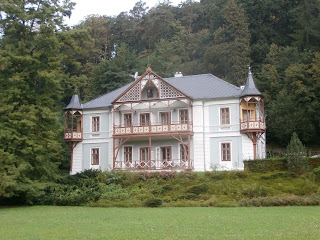In 2023 and 2024, on occasions of residing in Wisła, but not only, I have visited Czech Republic a few times year. The Poland south-western neighbour is a country to be either loved or disliked. With each next venture there, I belong more to the former group and with each next trip I see more reasons to fall in love with the country.
I am fond of the country's residents, straightforward, cheerful and laid back. As many Poles, I find their language hilarious, yet with time it gets intuitive, hence despite many false friends, I find it easy to communicate with a Czech, when each of us uses their mother tongue.
Unlike Poland, Czechia is not a flat lowland. Its landscapes and undulating and much better looked after than in Poland. While outside towns the nature beckons, in towns public and private spaces are clean and tidy.
The country can boast of infrastructure friendly to anyone. Elderly, disabled, parents with prams, cyclists, pedestrians - they all have it easy to move about in the public space, whereas motorists are none the worse off it.
Czechs are more keen to take moderate physical exercise as a pastime activity. Stats show 55% of Czechs do regularly at least one sport, in line with the EU average and 20 percentage points more than in Poland. Sadly, my compatriots are third from the bottom in the ranking of most physically active EU nations.
The friendliness of the country spurs fertility. Atheist Czech Republic, where abortion on demand is allowed, has fertility rate between 1.70 and 1.80, while in catholic Poland it recently declined to 1.16.
Czechs tend to spend more time outdoors, including eating, drinking and socialising. Prices at eateries and bars are much more affordable than in Poland. A half-litre beer or a glass of wine for less than the equivalent of 7 Polish zlotys, or a decent lunch with a beverage for less than the equivalent 40 zlotys are easy to find.
We took a trip to the southern neighbour again, for the long weekend. We both had an intense time at work, which prevented us from extending it, so we drove out of Wisła on Thursday morning and returned on Sunday.
Our first stopover was in Pustevny, some 100 kilometres from the Polish border. We hiked through the forests and had a lunch at a beautifully preserved former mountain hostel.
The next stop was a town of Roznov, with a nice market square and a viewing tower overlooking the town. From there we headed for our lodgings in Luhacovice (a sanatory resort).
The region is not as full of vineyards and cellars as the southern Moravia, but still you can find plenty of them. Here, we pass some windowless wine storage huts, on our cycling trip (75 kilometres covered on two wheels on Friday in heat reaching up to +34C).
Given the strain, the heat and distance of over 30 kilometres from our accommo- dation, we resolved to return to Luhacovice by train (our bikes hung on racks similar to those in Koleje Mazowieckie trains). Another thing I adore in Czech Republic is that the country does not leave its citizens car-dependent. Each and every village has a few buses a day running, while the train we boarded connected Luhacovice and Prague, the service runs every two hours on weekdays!
The very spa town of Luhacovice dates back to the nineteenth century and is a heritage of Austro-hungarian realms, with superbly preserved pieces of architecture erected before WW1. On the second day we took a round trip from Bzenec which is a centre of wine-growing industry in Zlinsky kraj. A three-kilometre ascent to the winery proved rewarding.
The next trip to Czechia is quite unlikely in 2024, yet looking forward to the next voyages in 2025.






